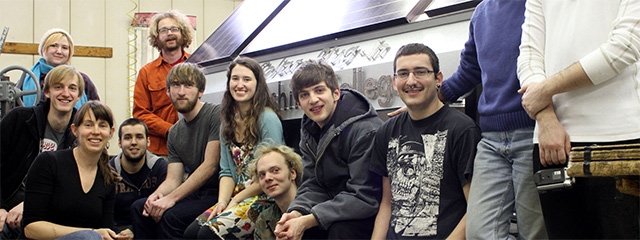While pursuing an MFA in design at the University of Texas at Austin, Beth Ferguson 96F bought an electric scooter on Craigslist. When she couldn’t find a place to charge it, she created a solar-charging station on campus. The SolarPump Charging Station became her thesis project, and she wrote a business plan for a course she was taking on social entrepreneurship. Thus was Sol Design Lab launched.
A representative of the South by Southwest music festival saw her thesis presentation, and SXSW commissioned three charging stations for the 2010 event as a carbon-offset initiative.
They attracted attention for both their efficient generation of green energy and Ferguson’s sly humor: Her design converted a 1950s gas pump, the symbol of American car culture, into a solar-charging station.
“The charging station is perfect for cities, colleges, and music festivals,” says Ferguson. “People come to it to recharge bikes and phones, and it provides a springboard for conversations about climate change.”
It didn’t take long for Ferguson to bring her ideas back to Hampshire, where she had studied environmental design and spent countless hours developing her skills as a maker
and innovator.
“A lot of my spirit was developed at Hampshire,” she says. “I love coming back.” A talk at the College about the SolarPump led to an invitation to co-teach a Jan term course. Working with applied design professor Donna Cohn and Sol Design Lab colleague Dallas Swindell, she guided 16 students as they built a solar-charging station for the campus. Set on a four-foot by eight-foot boat trailer with wheels, it’s mobile but lives mostly near the bell in front of the library. It provides a handy space to recharge computers and mobile devices, plus it can power speakers for outdoor concerts. Pop-out seating and tabletops are built from recycled road signs. The solar panels form an H and glow at night in the shape of the Hampshire logo.
 Ferguson returned the next year, 2012, to co-teach a course in upCycling, during which students constructed a bus-stop installation from 1,500 plastic drink bottles pulled from dumpsters in the Five College area. The class she taught in January 2013 focused on electric bicycle-share networks. Students designed a Five College bike-share system that they hope to develop on campus next year. The course stressed ecological design principles and energy challenges in urban settings.
Ferguson returned the next year, 2012, to co-teach a course in upCycling, during which students constructed a bus-stop installation from 1,500 plastic drink bottles pulled from dumpsters in the Five College area. The class she taught in January 2013 focused on electric bicycle-share networks. Students designed a Five College bike-share system that they hope to develop on campus next year. The course stressed ecological design principles and energy challenges in urban settings.
She’s always been interested in urban centers, Ferguson says. For her Div III, she worked with the Green Map System, mapping community gardens and toxic hot spots in Holyoke.
Now based in San Francisco, Sol Design Lab is partnering with electric-scooter and bike-share programs to design solar-charging stations that will meet their networks’ needs. A charging station in New York City is on the schedule for this summer; the benefits of a free public space to recharge mobile electronics became clear there in the wake of Superstorm Sandy, Ferguson says.
Her entrepreneurial ventures also serve as educational outreach. In addition to the Hampshire Jan terms, Ferguson has taught workshops in the design program she attended at the University of Texas, and a $60,000 grant to Sol Design Lab will fund a permanent solar-charging station there. At Stanford University, a graduate engineering student group called Engineers for a Sustainable World has asked the company to design curriculum for it.
“A lot of my spirit was developed at Hampshire.”
Ferguson credits Hampshire with giving her the ambition, as she puts it, “to go out there and be a problem solver, to be entrepreneurial and to have a firm belief in solutions for urban sustainability.” She says two things Hampshire provides have proved particularly helpful to her: grant-writing opportunities for students (“that played a valuable role in preparing me to pitch ideas”) and encouragement to women in science and design to pursue entrepreneurial goals (“women, if given support, can really come up with new ways of thinking”).






Great work Beth. I think electric scooters and bikes for adults have a huge role to play in the future transport but of course we still need to increase awareness of the products out there. Also, well designed charging networks are incredibly important for the average consumer to feel its worth investing in these products. Inspiring!